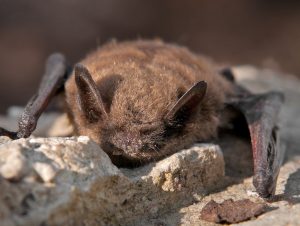
Little Brown Bat (Myotis lucifugus)
Continue reading to review some basic information about Little Brown Bats, including their scientific name and classification, as well as, their diet, range, habitat, and more!
The Little Brown Bat
Little Brown Bats are microbats, meaning they are nocturnal, generally small, and primarily retain an insectivorous diet of insects and other bugs. They can consume 50% of their weight in insects! And during gestation or lactation, they eat even more. Breeding season is generally around September and October, but females actually store the male sperm for springtime fertilization, making baby bats born in the summer. Gestation is generally 50 to 60 days, and once born, sexual maturity is reached between 6 and 8 months. Females generally give birth to just one bat pup a year, but sometimes two.
Physical Description
The Little Brown Bat, sometimes referred to as Little Brown Myotis, is scientifically named Myotis lucifugus. Myotis refers to a “mouse-eared” genus of bat. They are among the most common bats found in North America. Above, they are covered in shiny brown, sleek-looking fir, with a lighter patch of fir below. They are usually around 3 to 3 ½ inches in length and weighing only a fraction of an ounce, between 1/8 and ½ ounces. So needless to say, their name says it all because they are little for sure! Although small, their average wingspan will surprise you, as it is more than double their body length, averaging between 6 to 8 inches in width. But what’s even more interesting is that they can live up to 30 years or more, average between 20 and 30 years specifically.
Echolocation
Little Brown Bats use a system of sonar called echolocation, combined with their acute sense of hearing, to locate and hunt down prey. Echolocation is a natural built-in sonar system for bats. They send off sounds that make a mental-grid of their surroundings by bouncing off objects and returning to the bat. They also communicate with one another through a complex series of chirps, beeps, and high-pitches sounds; most of which are not detectable by human ears.
Range
The geographic range of the Little Brown Bat species includes 37 states, as well as, Southern Canada east of British Columbia. Part of this range includes Kentucky. They are often found roosting in the Northern parts of the state, also as their name suggests. Additional U.S. states include Alabama, Arkansas, Connecticut, Delaware, Georgia, Illinois, Indiana, Iowa, Kansas, Louisiana, Maine, Maryland, Massachusetts, Michigan, Minnesota, Mississippi, Missouri, Montana, Nebraska, New Hampshire, New Jersey, New York, North Carolina, North Dakota, Ohio, Oklahoma, Pennsylvania, Rhode Island, South Carolina, South Dakota, Tennessee, Vermont, Virginia, West Virginia, Wisconsin, and Wyoming.
If You Have a Nuisance Bat Problem…

Louisville Bat Removal 502-553-7622


